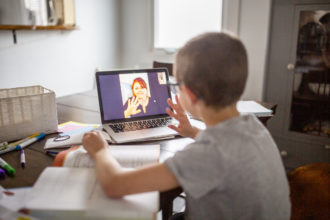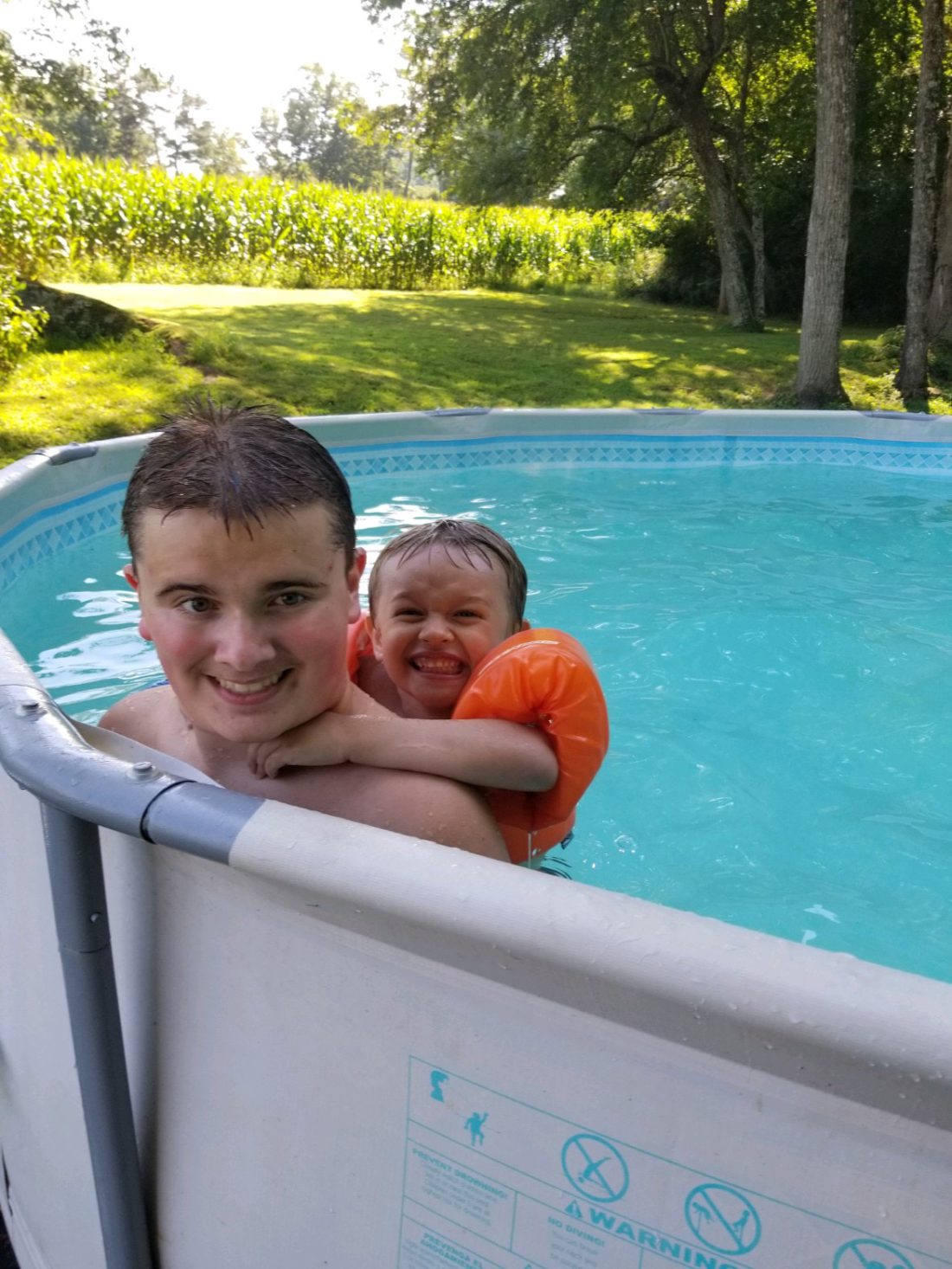Before COVID-19 — before Shannon Cooper’s world was flipped upside down — her two autistic sons were thriving.
Angus, Cooper’s 5-year-old, was excited to start kindergarten at Avery’s Creek Elementary School. Avery, her 16-year-old, was enrolled in the Progressive Education Program at T.C. Roberson High School, learning how to do everything from expressing his needs to cleaning laundry.
They aren’t thriving now.
Virtual learning is a constant challenge, Cooper explains. Avery, who has difficulties with verbal communication, isn’t able to engage with his teachers or classmates as he usually would, if he can focus on online instruction at all. Angus has yet to meet many of his teachers in person, and Cooper feels he’s been lost in the system. Both Cooper and her husband, Jason, work full time and leave their sons in the care of Jason’s mother during the day.
Even with the in-person instruction, therapy and support provided by public schools in normal times, Cooper says, giving her sons a quality education hadn’t been easy. But those school-based resources aren’t available remotely — and federal limitations to Medicaid have kept the Coopers from filling that essential gap in help for their kids.
Like many mothers of children with disabilities, Cooper is now having to make difficult decisions about her family’s future. Does she take her kids out of school? Should she quit her job to help her sons? If she stops working, how will her family pay their bills?
“Most days, we don’t have a whole lot of hair left on our heads,” Cooper says with a sad chuckle. “It’s been so, so hard.”
Red tape
Governmental support for students with disabilities is typically distributed in two ways: Innovations Waivers and state services, explains Janet Price-Ferrell. She’s the executive director of FIRST, an organization that provides assistance to Western North Carolina families and individuals with disabilities.
The main funding source is the Medicaid-supported Innovations Waiver, which provides school-age children with up to 54 hours of services a week during the academic year and up to 80 hours during the summer months, depending on the severity of their needs. The program’s waitlist, adds Price-Ferrell, is several years long; by the time recipients qualify, the majority are in their late teens. State services and other types of funding combine Medicaid and state money and rarely support more than 10 hours of help per week.
No Medicaid-funded support can be used during the school day, says Price-Ferrell. Normally, that’s not a problem — under the federal Individuals with Disabilities Education Act, public schools must provide a free, appropriate public education to all students, including special education programs and services like occupational, speech and physical therapy to help children succeed.
In the spring, when states were still under lockdown orders to prevent the spread of COVID-19, those rules were relaxed by the Medicaid division of the N.C. Department of Health and Human Services in alignment with federal recommendations. Families and caretakers were allowed to draw additional hours from their Medicaid plans to help with in-home services and accommodations, even though schools were operating remotely. Spring then became summer, and schools officially closed for vacation, meaning families continued to receive their maximum Medicaid hours.
But in late July, the federal Centers for Medicaid and Medicare Services determined that the previous flexibilities in increased hours for school-age children would not apply for the 2020-21 academic year, says Allison Inman, spokesperson for local Medicaid management organization Vaya Health. Medicaid services could no longer be used during the school day, despite the limited support students would receive from schools in the virtual learning environment.
The announcement sent families reeling. “Parents are now literally deciding whether they keep their job or stay home with their kids,” Price-Ferrell says.
Schools, dazed

Every additional month that students with disabilities are kept out of the classroom compounds enormous setbacks in their learning, says Gaile Osborne, a child advocate and school liaison at FIRST. But as schools try to mitigate those setbacks, she says, they will by necessity focus on the most vulnerable groups, then shift efforts to higher functioning children who may be able to access virtual learning platforms.
“The schools are triaging, in a sense,” Osborne says. “They’re going to peel the onion layers off slowly as they begin to serve our students.”
To receive special education services, students must have an Individualized Education Plan, which outlines what support a child needs to learn. As soon as Medicaid announced that available service hours would be calculated based on the time spent receiving academic instruction, parents and special education teachers rushed to amend IEPs to reflect a shortened school day, thereby qualifying for more federal support.
At Asheville City Schools, says spokesperson Ashley-Michelle Thublin, all services that were in place before the pandemic are still being delivered virtually; IEPs are being adjusted to include telehealth visits, assistive technology and text-based alternative assignments. Special education staff members are closely monitoring student performance and will adjust future services accordingly, she adds.
The Buncombe County school district serves over 3,000 students with IEPs, says spokesperson Stacia Harris. The district extended in-person learning opportunities to some of its most vulnerable students on Sept. 8, she says, including students enrolled in the Progressive Education Program or Intensive Intervention class and those receiving physical, occupational or speech therapy.
“While these opportunities impact our students with the greatest need for in-person learning, the district intends to broaden its scope of outreach to students who are also in vulnerable learning situations,” Harris says. “This will include students who are in other Exceptional Children groups, English Language Learners students and other students with individual needs.”
Local schools are genuinely trying to do the best they can, emphasizes Osborne. Teachers are willing to meet with parents over lunch breaks or in the evenings after work, she says, and administrators are eager to discuss alternative solutions. Yet some of the most important lessons children in special education classes learn — social skills, how to interact with others, how to communicate — can’t be taught over a computer.
“Everyone is overwhelmed. The families are overwhelmed, the kids are overwhelmed, the teachers are overwhelmed,” Osborne says.
Impossible choices
Life right now is all about survival, says Jillian Martin. Her 15-year-old son has autism, ADHD and other behavioral disorders, but instead of attending the Progressive Education Program classes at Valley Springs Middle School as he did before the pandemic, he’s stuck at home all day. He doesn’t understand what’s going on, Martin says, and wants to know when he can go back to school.
Martin and her husband are both essential workers and can’t leave their jobs to stay home and help their son. Instead, they depend on the support provided by the Innovation Waiver to get through the day. The Martins amended their son’s IEP so he could receive more Medicaid hours but are still waiting for confirmation that the changes were accepted.
It’s hard enough for her son’s educational needs to be met in the classroom with a trained special education teacher, Martin says. Spending his day with a caretaker who doesn’t have much experience teaching, she continues, is a recipe for failure.
“He is regressing,” Martin says. “Without a shadow of a doubt, he is regressing.“
Angela Roberts and her family are in a similar situation. Roberts’ autististic daughter, Anna, is a 10th grader at Hendersonville High School and is enrolled in an occupational program that teaches job skills to help her succeed after graduation. Virtual school means Anna and her classmates can’t go out in the community to complete the program’s requirements, Roberts says.
Roberts is also concerned that the sudden federal Medicaid decisions set a dangerous precedent for cutting services in the future. “The irony is that the Innovations Waiver was designed specifically to keep our special needs loved ones out of institutions and in the home and in the community,” she says. “Eliminating the opportunity to have the supports in place during this critical time is going against everything that Innovations stood for to begin with.”
As schools decide whether and how to bring kids back to the classroom, Martin urges them to consider the needs of students like her son, who don’t have any other options.
“There is no virtual school for these kids,” Martin says. “For most, school really prepares them for life. And it’s devastating because the goal for all of these individuals is to live successful lives and learn the skills they need to function in the future. By not being in school, they’re not going to meet that goal.”




A terrible situation all around. If Covid-19 has proved anything, it’s that education, at every level, is basically day care. And that “parents” can’t actually parent because: a) they have no day care and: b) they could have avoided much of their own misery by not having children in the first place. As a humorous aside, it always causes a chuckle to see these supposedly happy parents pushing the stroller around looking morose. Almost as if the realization hit them (hard) that maybe producing environmentally destructive spawn wasn’t the wisest choice after all. Dummies. That’s what happens when you let your genitals think for you.
While I greatly appreciate this article, I encourage the author to consider the use of person-first language in future writing.
https://en.wikipedia.org/wiki/People-first_language
Thanks!
True ignorance shown in the comments which proves just how truly uneducated you are, how ignorant you are, and with absolutely no experience which is clearly obvious. You are so quick to pass judgment on others. I am sure your mother would hang her head in shame to read your comments and referring to children of disabilities with such evil malicious words.
Obviously Covid has shown how ignorant and nasty people really are. For one to think that parents have a choice as to whether or not they have a child with special needs shows just how unempathetic our society has become. The world does not revolve around YOU. To refer to autistic children as environmentally destructive spawn is mind-blowing. I hope you do not have children. Or any pets for that matter. Oh yeah, and since one cannot control what life hands you in terms of your physical well-being, you better hope you never have any circumstances that render you a special needs person (other than your moronic opinion) because you very well may get a caretaker who has your attitude about people who are not considered “normal” . What you give out, you get back. Remember that